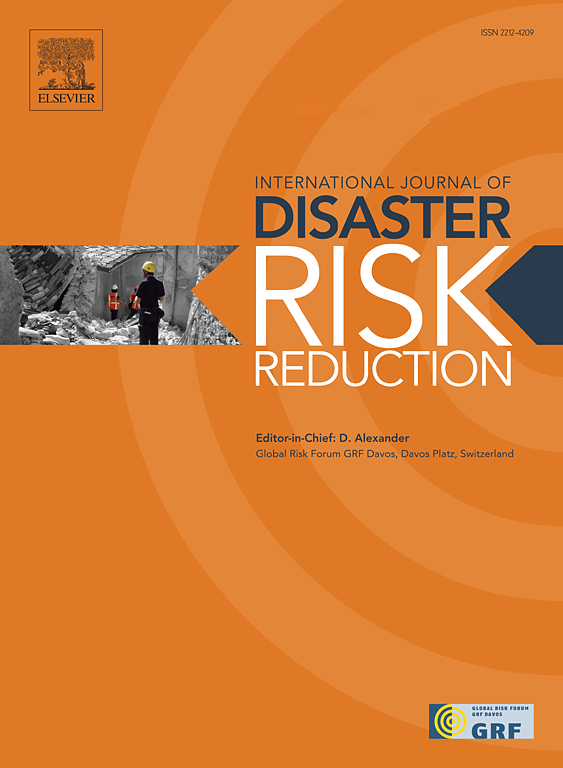Comprehensive drought risk assessment and its driving mechanism for the water source area of the Western Route of South-to-North Water Diversion Project in China
IF 4.2
1区 地球科学
Q1 GEOSCIENCES, MULTIDISCIPLINARY
International journal of disaster risk reduction
Pub Date : 2025-04-15
DOI:10.1016/j.ijdrr.2025.105423
引用次数: 0
Abstract
The Western Route of South-to-North Water Diversion Project (WR-SNWDP) is a key national infrastructure in China to transfer water from the headwaters of the Yangtze River. The complicated environment and escalating climate change impacts, such as extreme droughts in the upper Yangtze Basin, pose serious challenges to the implementation of WR-SNWDP. However, the spatio-temporal evolution of drought risk and its driving mechanism in this area remains unclear. Here, the water source area of WR-SNWDP was selected as the study area and drought hazards characteristics were first extracted considering both the meteorological and hydrological drought indices. A multi-dimensional drought evaluation system of “hazard, vulnerability, and exposure” was established that takes into account ecosystem resilience as well as disaster prevention and mitigation capacity. A Random Forest-based comprehensive drought risk assessment was conducted from 2001 to 2018, and the driving mechanisms were analyzed using Geodetector. Our results indicate that there are evident spatio-temporal heterogeneities of drought risk with high risk areas shifting westward, particularly in the Tongtian and Jinsha River Basins. Drought risk peaked in 2006, with ecosystem resilience playing a significant role in response to drought risk formation. Precipitation, temperature, and vegetation are dominant factors, and their interactions, particularly between precipitation and vegetation, strongly explain drought risk evolution. The results underscore the significant trends in spatio-temporal shifts of drought risk in the context of climate change and highlight that more attention needs to be paid to the coupling effects among driving factors on drought risk in the water source area of WR-SNWDP.
南水北调西线水源区干旱风险综合评价及其驱动机制
南水北调西线工程(ww - snwdp)是中国长江上游调水的重要国家基础设施。长江上游地区极端干旱等复杂的环境和不断加剧的气候变化影响,给南水北调工程的实施带来了严峻挑战。然而,该地区干旱风险的时空演变及其驱动机制尚不清楚。选取水源区作为研究区,首先综合考虑气象干旱指标和水文干旱指标,提取水源区干旱灾害特征。建立了综合考虑生态系统恢复力和防灾减灾能力的“危害-脆弱性-暴露”多维干旱评价体系。基于随机森林的2001 - 2018年干旱风险综合评估,利用地理探测器分析干旱风险的驱动机制。结果表明:中国干旱风险的时空异质性明显,高发区向西转移,通天和金沙江流域尤为明显;干旱风险在2006年达到峰值,生态系统恢复力在应对干旱风险形成方面发挥了重要作用。降水、温度和植被是主导因素,它们之间的相互作用,特别是降水和植被之间的相互作用,有力地解释了干旱风险的演变。研究结果表明,气候变化背景下,水源区干旱风险的时空变化趋势显著,需要进一步研究水源区干旱风险驱动因素之间的耦合效应。
本文章由计算机程序翻译,如有差异,请以英文原文为准。
求助全文
约1分钟内获得全文
求助全文
来源期刊

International journal of disaster risk reduction
GEOSCIENCES, MULTIDISCIPLINARYMETEOROLOGY-METEOROLOGY & ATMOSPHERIC SCIENCES
CiteScore
8.70
自引率
18.00%
发文量
688
审稿时长
79 days
期刊介绍:
The International Journal of Disaster Risk Reduction (IJDRR) is the journal for researchers, policymakers and practitioners across diverse disciplines: earth sciences and their implications; environmental sciences; engineering; urban studies; geography; and the social sciences. IJDRR publishes fundamental and applied research, critical reviews, policy papers and case studies with a particular focus on multi-disciplinary research that aims to reduce the impact of natural, technological, social and intentional disasters. IJDRR stimulates exchange of ideas and knowledge transfer on disaster research, mitigation, adaptation, prevention and risk reduction at all geographical scales: local, national and international.
Key topics:-
-multifaceted disaster and cascading disasters
-the development of disaster risk reduction strategies and techniques
-discussion and development of effective warning and educational systems for risk management at all levels
-disasters associated with climate change
-vulnerability analysis and vulnerability trends
-emerging risks
-resilience against disasters.
The journal particularly encourages papers that approach risk from a multi-disciplinary perspective.
 求助内容:
求助内容: 应助结果提醒方式:
应助结果提醒方式:


